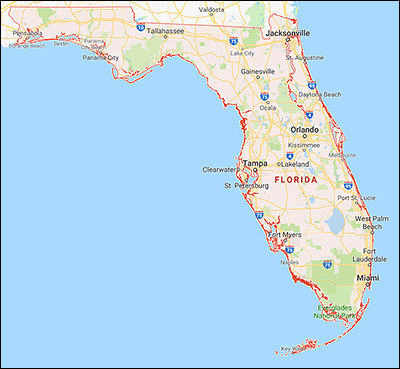By Jim Ellis
 Dec. 18, 2020 — Continuing with our project this week of analyzing statewide data now that official final election results are being published from around the country, today we look at the Sunshine State of Florida, another key redistricting state.
Dec. 18, 2020 — Continuing with our project this week of analyzing statewide data now that official final election results are being published from around the country, today we look at the Sunshine State of Florida, another key redistricting state.
Though having only three-quarters of Texas’ population, the Florida presidential turnout came within only a few hundred to equaling that of the Lone Star State (FL: 11,067,366; TX: 11,315,056).
On the statewide tally, President Trump carried Florida with a 51.2 – 47.5 percent margin over former vice president Joe Biden. The result represents a net 2.2 percentage increase for the president when compared with his 2016 statewide total, while Biden’s performance registered a decline of 0.3 percent from Hillary Clinton’s Sunshine State aggregate vote.
The House performance detected in California and Texas, showing that the average victorious congressional candidate performed better within their particular district than President Trump, was not nearly as pronounced in Florida.
On average, Texas US House Republican candidates ran 2.8 percentage points better than Trump, and the average California GOP House candidate ran 4.2 points ahead of the president’s statewide percentage. In Florida, however, the number was virtually equal to the president’s, with the average House Republican contender running just 0.2 percent above Trump’s statewide total.
Because two of the Republican incumbents, Reps. Neal Dunn (R-Panama City) and Mario Diaz-Balart (R-Miami/Hialeah), ran either without Democratic opposition (Dunn) or totally unopposed (Diaz-Balart) the Florida Secretary of State does not record votes in such a district. Therefore, for purposes of this exercise, a projected result of 65-35 percent for the two congressional districts was added as an estimated total. This percentage spread was extrapolated when comparing the performance of Republican and Democratic congressional candidates in similar Florida districts.
To review, in California, Democratic House incumbent performance fell below their 2018 recorded vote in 33 of 44 districts, while results improved for four of the six Republican incumbents on the ballot. In Texas, vote percentages for 11 of the 16 Republican incumbents seeking re-election improved from 2018, while the Democratic incumbent performance index declined for all 13 who ran for a succeeding term.
The Florida congressional vote was similar to the two states in comparison. Here, eight of the 10 2020 GOP incumbents on the ballot improved their result from 2018, where all eight Democratic incumbents saw a vote decline when compared with their performance of two years ago. Five additional Democratic representatives were without Republican opposition in 2018, so their performance was not included in the comparison to the 2020 result when they did have GOP opponents.
On the redistricting front, estimates suggest that Florida will gain two new congressional seats in 2020 reapportionment, and it appears clear where those additional districts will need to be placed.
A huge population increase appears both in the Orlando/Central Florida region and along the Gulf Coast sector. The latter area is made even more obvious for a seat gain because though the South Florida seats look slightly over-populated, the shedding of district population to other areas must be pushed northward because these districts are surrounded by water on three sides.
Based upon our rudimentary calculations, the target population number for the 2021 Florida congressional map appears to arrive at 740,611. If this total proves near correct, then just two districts, FL-2: Rep. Neal Dunn (R-Panama City) and FL-13: Rep. Charlie Crist (D-St. Petersburg) are under-populated. One district, that of Rep. Darren Soto (D-Kissimmee) in the Orlando area, holds more than 900,000 people (931,872 according to the latest available US Census Department numbers), while 11 seats host more than 800,000 individuals.
The vast majority of those in the latter category lie in the Orlando and Gulf Coast regions, though the Atlantic Coast 4th District (Rep. John Rutherford-R) and South Florida 20th District (Rep. Alcee Hastings-D) also exceed the 800,000 population figure.
Therefore, as we’ve seen in Texas, we will likewise see a spirited re-districting fight in the Sunshine State as the large and growing population is again divided among the parties and geographic regions.
